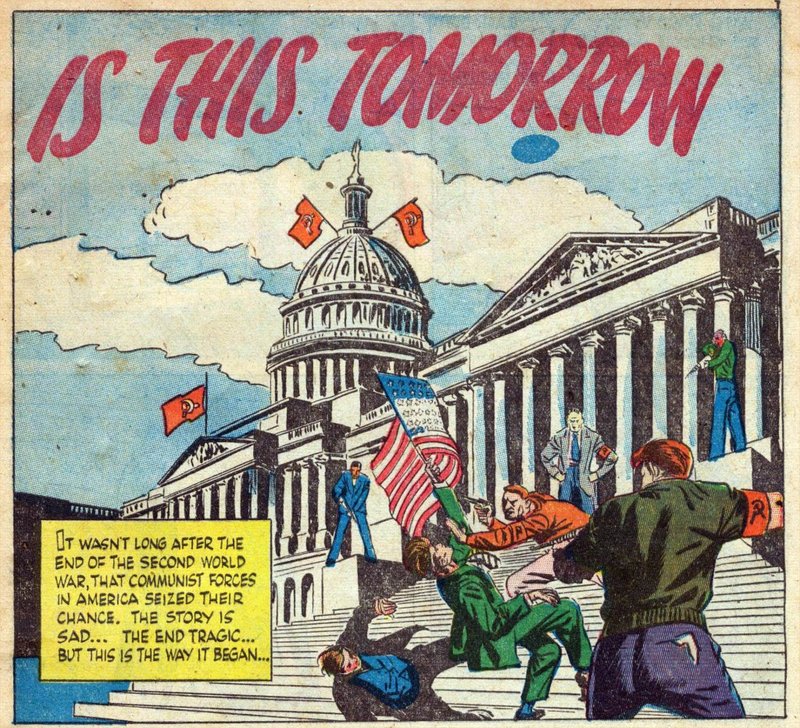Student Work
Cold War
By: Claire Stewart

In 1947 the Catechetical Guild Educational Society in St. Paul, Minnesota put out this warning against Communist infiltration./https://flashbak.com/tomorrow-red-scare-comic-book-1947-391142/
Men Provide, Women Survive
Advertisers made it their mission on how to educate the postwar woman in the successful ways of being a beautiful all-American housewife figure and; they were successful. Neilson’s department store is the perfect picture of a small-town Hallmark Christmas movie it is located in the heart of Oxford on the square in Mississippi. Its goal, like other department stores, is to keep its locals up to date on the latest trends in the fashion industry and, they have since 1839 when William Smith Neilson moved to Oxford from East Tennessee. It is target audience like most historical sites have changed over the years, for decades men were whom advertisers saw as the goal. It was not until the post-war did they see a shift, from the men to the women. For example, the new at the time Seventeen magazine that had numerous articles focusing on how to plan a wedding while juggling high school to the middle age ladies reading U.S. Lady and how to cover up fine lines and wrinkles. The Cold War and all of the anxieties it entailed added to this domestic shift as the media encouraged American women to be everything Soviet women were not: beautiful, well-mannered, and exceedingly happy in their homes.[i] Advertisers and social cues made it seem like being an All- American beauty queen running a household was another way to support American victory and their fight against Russia to the flight to space.
In Ledger number 44, from Neilson’s department store on May 22, 1956, Miss. Hoop purchased a Columbia Records Club membership[ii]. Since accounting books became more basic before this time, it is difficult to find a particular person or thing that someone bought because it only describes either one’s last name or an item that they rarely bought if ever it had their name and what they purchased. So, for this account, the article focuses on Miss. Hoop is an example of how advertisers motivated presumably teens and centers on female teens. Nowhere else in the Ledger does it specify the title of the buyer except for this female and this item bought. This shows not only how young this girl was but also how important it was to state that she bought into a record membership alone. She was not with her mother, father, or any other friends or family and she came in to buy this particular item. That was not uncommon at the time, however, considering the war that went on before it was for the older generation, they had a huge set back because of the aftershock to the men, women, and nation.
Ledger 44, May 22, 1956 from Neilson’s Collection, Department of Archives and Special Collections, The University of Mississippi Libraries.
After World War II there was a lot of question about how the countries could make a comeback after such a devastating blow, what people had come to know from the decades before and the multiple years during the war was wiped out. The men that were left were returning to changed nations, especially the United States. After the war, many women went back to the kitchen and so came joys now that they after free from arduous labor and back to showing their families their love and protection by serving well-chosen Jell-O meats. America hit its peak after World War II, the economy was bombing, and the Americans paycheck was never as deposable as it was then. Continually rising wages coupled with the economic advantages that the G.I. Bill presented created a generation of rapacious consumers[iii]. Men are the providers and women as the consumer. Even though advertisers were dismissing hundreds of thousands of women, they advertised to one particular group, white -middle class- women. These images are precisely the material that advertising agencies during the postwar years rallied behind[iv]. How else can advertisers sell Betty Crocker’s cake mix without depicting the perfectly happy mothers serving a triple chocolate cake? This was extremely important in the south and especially in Oxford, Mississippi where the perfect southern bell barbie came to life on the University of Mississippi’s campus.
[i] See Elaine Tyler May‘s analysis of the implications of the famous 1959 ―Kitchen Debate‖ in Homeward Bound: American Families in the Cold War Era (New York: Basic Books, 1988), 13.
[ii] Ledger #44 Day Book, 22 May 1956, Neilson’s Collection, Department of Archives and Special Collections, The 3 University of Mississippi Libraries.
[iii] Juliann Sivulka, Soap, Sex, and Cigarettes: A Cultural History of Advertising in America (New York: Wadsworth Publishing, 1998), 241.
[iv] Historian Joanne Meyerowitz and film and literature authority Leonard J. Leff further explain the role mass media played in women‘s return to the home after the war in their works, Not June Cleaver: Women and Gender in Postwar America, 1945-1960 (Philadelphia: Temple University Press, 1994) and ―What in the World Interests Women?‖ Journal of American Studies 31, no 3, part 1: Looking at America: The USA and Film (1997): 385-405, respectively.
